More than 50 years after the ill-fated Concorde jet took to the skies and made supersonic air travel a reality, Denver-based Boom is trying to revive the dream of traveling at the speed of sound.
The Concorde was a technical marvel, but it never overcame its economic challenges, which resulted in flights that were astronomically expensive. That inability to reach mainstream flyers led to its official demise in 2003.
Boom’s founders believe advances in materials and designs will allow them to build a 75-seat supersonic jet that flies at twice the speed of sound. That would cut the time of a transatlantic flight to around three hours and begin a revolution in business travel, as well as tourism.
“Our vision is to make the world more accessible,” said Boom cofounder and CTO Joe Wilding. “We’re trying to do that by removing the barriers that people have to experiencing the planet.”
June 5th: The AI Audit in NYC
Join us next week in NYC to engage with top executive leaders, delving into strategies for auditing AI models to ensure fairness, optimal performance, and ethical compliance across diverse organizations. Secure your attendance for this exclusive invite-only event.
Wilding spoke to VentureBeat as part of a podcasting partnership with Samsung Next at the recent Slush technology conference in Helsinki, Finland. The full conversation can be heard here:
Boom emerged from Y Combinator in 2016 and has so far raised $151 million in venture capital to realize its ambition of designing a Mach 2.2 jet called Overture. Such a jet would fly about 2.5 times faster than the typical transcontinental jet of today and harken back to the famed Concorde. But that plane was only for the ultra-rich, with a London-New York ticket priced at $7,995 in 1997, or more than 30 times the cost of a typical ticket.
“Technologically, [the Concorde] was a great success,” Wilding said. “Economically, it was not, and it really was ahead of its time from an efficiency standpoint. And so ticket prices were insanely high on Concorde.”
In the 50 years since the first Concorde flew, advances in materials, engine design, and aerodynamics have changed the game, according to Wilding. That includes lighter composite materials used to build current airplanes like the Boeing 787 and the Airbus A350.
In the course of building these airplanes, the two companies, which essentially hold a duopoly over commercial airplanes, have won certification for a wide range of lighter and stronger materials and new engine designs that are more aerodynamic.
Such regulatory approvals can take a decade or more. In building the Overture, Wilding said Boom would essentially be able to use existing technology, rather than needing to make radical design or engineering breakthroughs on its own.
“That is a huge enabler for this technology to come back,” Wilding said. “So really those technologies converging in just a decade have really gotten us to where we are right now.”

Above: Joe Wilding, CTO and cofounder of Boom, speaking at Slush. Photo by Sami currently.
In terms of the engine, the company will purchase one from an OEM. Boom is currently negotiating with three potential partners to develop an engine that will only require some modification to fit the Overture’s design.
To keep the project moving forward, Boom also amended its original plan. While it’s still designing the Overture, the company is also creating a smaller version to demonstrate the technology, this one called XB-1.
“We’re building a one-third scale technology demonstrator aircraft,” Wilding said. “We’re about halfway through the build process right now.”
The goal is to roll out the XB-1 plane in 2020 and have it in the air shortly after that. It will fly Mach 2.2 using the same aerodynamics and materials as the full-scale airplane. The Overture is more likely to be ready in the middle of this decade, Wilding said.
Five years may feel like an eternity by internet or consumer electronics standards, but it’s pretty fast by aeronautic timelines. This means Boom is already thinking about how to tackle the aforementioned duopoly. The airline industry is so massive, winning just a sliver of it could be lucrative.
In Boom’s case, the company will target overseas flights, which are projected to carry about 65 million business class passengers by 2025 over 500 routes. That could require between 1,000 and 2,000 planes, and Boom believes it can capture a majority of this valuable market.
The pitch for airlines and business travelers goes like this: Imagine making a day trip from the U.S. to Europe. Get on the plane in New York and be in London for lunch. Hit some business meetings in the afternoon, then go have dinner and drinks with colleagues. Now fly back to New York, where you would land about two hours before you took off from London and be in bed by 11 p.m.
“That is a possible trip,” Wilding said. “That is a pretty massive change compared to what you can do today.”
Still, Boom’s journey toward a new supersonic jet must also address growing concerns about the impact of air travel on the environment. The movement to boycott air travel may still be small, but it has gained increased attention over the past year.
Wilding noted that while air travel has become a big target, it represents about 5% of global emissions. In searching for ways to tackle this issue, the company is watching development of electric technologies for planes, but it believes anything robust enough for long-haul flights is far over the horizon.
For now, such companies will lean on carbon offset programs, though Wilding acknowledges it’s not a long-term solution.
He’s more optimistic about advances in sustainable aviation fuels — synthetic jet fuels that work with current engine technologies. He said Boom is currently partnering with a startup called Prometheus that pulls carbon out of the air and turns it into fuel. This is one of a number of companies working on new “carbon capture” technologies. Wilding said the founders have shown Boom that the technology works but now face the challenge of scaling it to produce sufficient quantities.
“Our mission statement is about experiencing the world,” Wilding said. “And if we get destroyed in the process, it’s kind of counterproductive. We live here, too, and we very much care about the environment and protecting the Earth. So it’s something we think about a lot.”
Down the road, as the technology advances and costs come down, the company hopes to build jets for mainstream travelers, and perhaps even long-range domestic flights.
“We believe there’s a follow-on project at some point that’s even larger and that has some mix of [the] business and economy [sectors] that can still compete with [traditional] airlines,” Wilding said.
Over time, Wilding sees Boom’s jet as part of the larger revolution in mobility, with the potentially to dramatically reduce travel times while introducing new modes that could change both passenger travel and shipping.
“There’s a lot of synergy here between what we’re doing and what some of these other startups are looking at,” Wilding said. “Hopefully, society can speed things up — like security and baggage claim — and really attack this whole travel thing from every angle.”
Updated 2 p.m. Pacific with comments addressing the environmental impact of supersonic travel.



